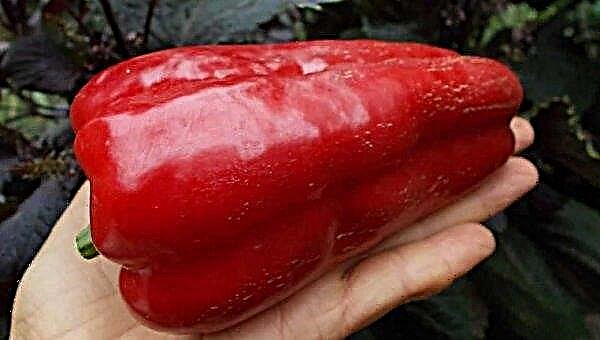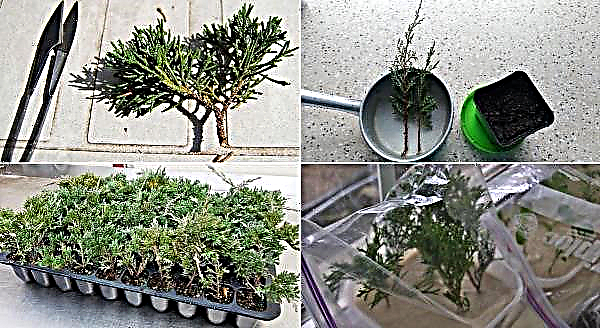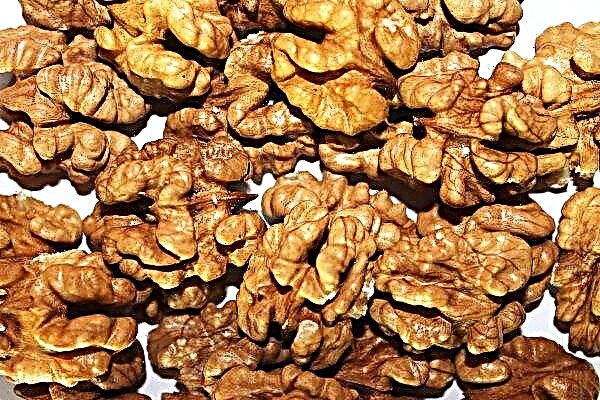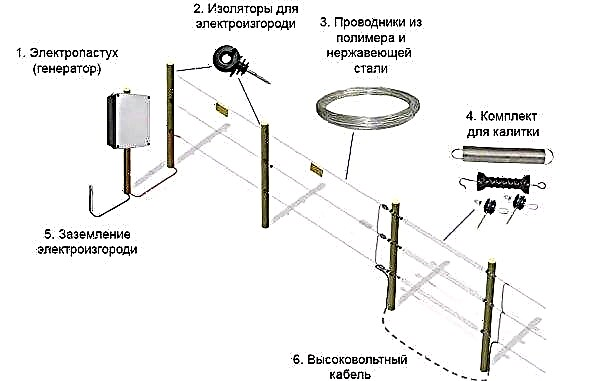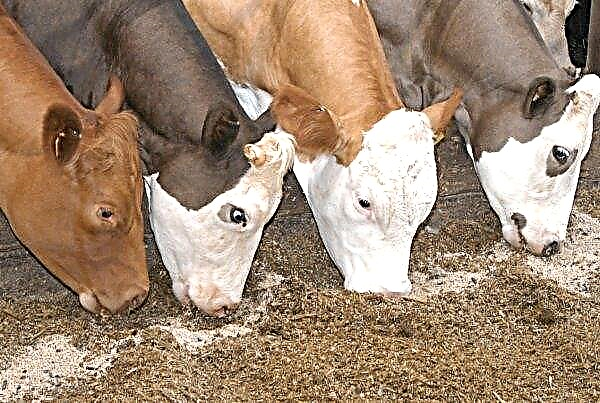In breeding chickens, poultry breeders are faced with a rather large number of troubles and problematic moments: birds are often susceptible to infectious diseases of the respiratory system, diseases of the joints, and often freeze out in severe frosts. A rather common problem is the unpleasant odor in the chicken coop. But modern technology offers a solution to many of these difficulties, for example, using bedding with live bacteria. We will talk about this later.
What is a litter with bacteria?
Litter with bacteria includes a wide range of special microbiological and enzymatic components that are added to the layer consisting of shavings, straw, sawdust, soybean meal, peat from moss and other suitable materials. Bacteria for the substrate are produced in the form of granules, solutions, and powders. The formation of the bedding layer on the basis of microorganisms, which will subsequently be used for more than one year, is recommended in early autumn - pores characterized by dryness and warm air temperature.
The formation of the bedding layer on the basis of microorganisms, which will subsequently be used for more than one year, is recommended in early autumn - pores characterized by dryness and warm air temperature.
A deep substrate with aerobic bacteria should be up to half a meter high. First of all, it is needed in winter. Thanks to the presence of microorganisms, conditions are created for a comfortable and warm stay of birds in the chicken coop even at very low outdoor temperatures. Indeed, because of the ability of the components to decompose, the fermentation litter has the ability to heat up to +30 ° C and above, therefore it acts as an excellent way of heating.
In an ordinary substrate for chickens, litter, getting into bioorganic materials, provokes putrefactive and fermentation processes, thereby becoming a hotbed of the formation and reproduction of pathogenic microorganisms, which leads to diseases and death of birds, a very unpleasant smell in the chicken coop. Bacteria in a modern litter together with oxygen contribute to the conversion of organics into valuable compost, fermenting it.Important! The term of use of the substrate with bacteria is from two to three years, after which it must be removed from the chicken coop.
Pros
Litter with bacteria has a number of undeniable advantages over conventional chicken substrates.
- Aerobic bacteria in them do not allow the development of pathological microflora, so the substrate with bacteria have many advantages:
- this is a great way to prevent various diseases of birds and resistance to them;
- birds remain clean;
- comfort of keeping animals due to the absence of unpleasant and pungent odors in the chicken coop;
- fermentation of the organic components of the substrate and the generation of additional heat, which saves on heating the chicken coop;
- due to the significant period of use of the bacterial litter, the need for frequent cleaning of the chicken coop and improvement of the place for storing bird droppings disappears;
- as a result of using the bacterial litter, an excellent organic compost is formed for further fertilizing the soil;
- the need to replace the substrate with bacteria occurs every 2-3 years, according to the norms;
- low consumption rates of enzyme litter per 1 square meter of area;
- thanks to the use of a sufficiently large layer of the substrate with bacteria, the floor of the room becomes soft and the risk of getting injured by birds when jumping from the pole is significantly reduced;
- reduced need for workers serving the chicken coop.
Important! Bacteria perform their tasks at temperatures above 0 ° C, therefore, in the room the temperature should be maintained at a level not lower than +1 ° C.
Minuses
With all the many advantages, the use of bacterial litter causes farmers some doubts and concerns.
- Many note a number of disadvantages of this product:
- often lack of certificates for goods of foreign (in particular, Chinese) production presented on the domestic market;
- with prolonged use of the substrate with microorganisms, according to the standards for use, the mechanism of its qualitative cleaning and disinfection is complicated, without which the product in practice is not able to maintain its productivity for two to three years;
- for the effectiveness of the product it is necessary to periodically add new microorganisms to the litter layer;
- it becomes difficult to keep a certain number of hens per square meter all the time the litter is used, according to the norms;
- high material costs for the acquisition of a bacterial substrate, a disinfectant solution for it, for the arrangement of enhanced supply and exhaust ventilation;
- it is often necessary to loosen and dig the litter for oxygen to enter its lower part;
- with insufficient ventilation, especially in the winter, a lot of moisture is formed;
- hungry chickens can swallow sawdust, which adversely affects the state of their digestive system.
Important! It is better not to use the bacterial substrate in rooms with a wooden floor, since bacteria are able to begin processing the tree, and the flooring may become unusable.
Basic selection rules
In the modern livestock market there are enough companies from Europe, Asia, as well as domestic origin, offering complexes of beneficial bacteria.
Almost all products are effective, but some rules should be followed when choosing:
- the product must have all the necessary certificates, accompanied by instructions for use;
- the choice should be guided by the reputation of the manufacturer, as well as user reviews of the product;
- Do not be guided by the price indicator as the main criterion: an expensive product is not always the highest quality;
- Before purchasing a product for the whole chicken coop, it is better to try it on a small part of your pets, carefully monitor their behavior;
- when choosing a product, it is necessary to check its expiration date, and also take into account the validity period;
- An important factor in the selection is also the form of release of biological bacteria, which should be taken into account for a specific use case;
- the products also differ in the active substance, which is also an important factor when choosing;
- Before you buy a product, you need to consider all the disadvantages when using it.
Did you know? Three times more representatives of chicken individuals than people live on the globe.
Features of using litter
Litter with bacteria, like any other product, has rules for use. It is necessary to take into account some of the nuances of its use in order to ensure maximum efficiency and productivity.
How to start bedding?
Particular attention is paid to the process of properly starting up the bacterial substrate:
- when choosing a time to start, preference is given to the period from the beginning to mid-autumn. If the process takes place in winter, then the room should be warmed up, and the substrate is recommended to be placed first in a warm room;
- first you need to clean the henhouse thoroughly, disinfect it with lime, which will prevent the accumulation of condensate;
- the floor must be paved with a substrate layer of any suitable material up to 50 centimeters thick (for stock when trampling);
- sprinkle bacteria on the surface of the substrate, not forgetting to monitor their uniform distribution;
- moisten the surface with spray water, mix with a shovel;
- after some time, the procedure for introducing bacteria must be repeated again;
- all procedures must be done according to the instructions;
- after six days, the temperature of the substrate should become higher, and then hens can be launched. Throughout this period, the litter does not need to be loosened so that microorganisms can earn.
Important! The best option for bedding with bacteria is sawdust up to 3 cm long. If they are smaller, then there is a possibility that they will quickly compress and oxygen will close. With a larger size, they will not be able to saturate normally with the waste products of birds.
Bacteria maintenance and care
The fact that the substrates with bacteria are designed for two to three years does not save farmers from manipulating their care. Bacteria, which are the main component of such a product, need nutrition and oxygen for their further reproduction and vital functions.
The following rules must be observed:
- It is necessary to monitor a certain number of animals per square meter of area, according to the instructions. With an insufficient number of birds, microorganisms will not have enough food, and they can disappear, with an overabundance of animals - they will not be able to handle the processing and can also die. If the norms for the number of individuals are exceeded, the litter is very compacted, the air stops flowing into it, so you need to turn the litter layer more often so that the bacteria do not die.
We advise you to find out
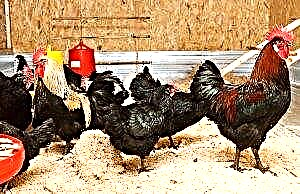
- In the chicken coop, quality ventilation should be equipped, because microorganisms during their work emit moisture, and they themselves do not tolerate it very well. The optimum level of air humidity in the chicken coop is not higher than 60%. In the hot season, it is necessary to carefully control the moisture content of the litter itself, with a significant decrease in it, to provide additional moisture.
- At least once every five days, the entire litter layer should be dug up to ensure air access.
- Microorganisms need periodic feeding, therefore, after digging, they need to be fed with a solution of 20 grams of microorganisms and one kilogram of sugar.
- Disinfection of the litter by various means to combat mice and insects is not allowed.
- The litter with bacteria must be changed no later than within the time specified in the instructions, since it will not be able to fulfill its purpose, pathogenic microorganisms, worms will begin to live in it.
Important! To eliminate problems with elevated temperatures in the hot season, the chicken coop should have a place without bedding to cool the chickens, if they need it.
Description of popular chicken bedding
Almost all bedding on the market by different manufacturers are characterized by efficiency in use. The differences are in the form of production, the main active ingredient and the cost of the product. But some bedding is in particular demand among farmers. Let's consider them in more detail.
"Baikal EM-1"
Means "Baikal EM-1" is a domestic product, which makes it much cheaper than similar foreign drugs. The quality and effectiveness of the application is in no way inferior to its foreign counterparts.
At first, plants were fertilized with the agent, but later they began to use it to organize bacterial litter for animals. The drug makes it possible to process bird droppings throughout the day. One glass of Baikal EM-1 must be diluted in a ten-liter bucket and the prepared litter soaked in the resulting solution.
Video: Baikal em-1 application for the chicken coop
Net Plast
Bacteria for litter "Net-Plast" - Chinese-made, based on enzymes of synthetic origin and sour-milk bifidobacteria. Litter based on this product does not warm above +25 ° C, but in practice this is quite enough for a comfortable keeping of birds. Attractive in the "Net-Plast" is that the drug is convenient to use: it only needs to be mixed with the bedding. Watering is not required. A pack of bacteria is enough to process litter up to 10 square meters.
Attractive in the "Net-Plast" is that the drug is convenient to use: it only needs to be mixed with the bedding. Watering is not required. A pack of bacteria is enough to process litter up to 10 square meters.
Did you know? Hens are capable of remembering more than a hundred faces, recognizing the owner from a distance of ten meters or more.
"BioGerm"
BioGerm bacteria is a German product and is presented in the form of granules of light beige or brownish tint. The composition of the drug, in addition to bacteria, also includes fragrances that can maximally eliminate unpleasant aroma in the room where the hens are kept. BioGerm must be applied in stages in two steps. First, the granules are scattered over the substrate layer, irrigated with water. After a few days, everything repeats again. Only then can hens take up the litter. For a square meter, 35 g of granules should be provided. The substrate with the use of "BioGerm" for up to two years.
BioGerm must be applied in stages in two steps. First, the granules are scattered over the substrate layer, irrigated with water. After a few days, everything repeats again. Only then can hens take up the litter. For a square meter, 35 g of granules should be provided. The substrate with the use of "BioGerm" for up to two years.
Did you know? In the last century, a case was twice recorded when a chicken was able to lay an egg with 9 yolks inside. One of these cases occurred in the USA, the other in the USSR.
"BioSide"
Bacteria "BioSide" - Russian production. They are presented in the form of dry components that need to be mixed with a layer of litter and get a quality litter with bacteria. Such a layer is able to warm up to +20 ° C. Such an irreplaceable substrate can act up to three years. The only thing - at least every five days you must not forget to dig it up and loosen it. Hens need proper care, a favorable microclimate, and cleanliness. Modern litter based on bacteria can help establish such conditions. It is precisely such technologies that help to avoid various problems with bird health, facilitate and simplify the work of farmers, and make the chicken coop atmosphere pleasant for the stay of both birds and people working in it.
Hens need proper care, a favorable microclimate, and cleanliness. Modern litter based on bacteria can help establish such conditions. It is precisely such technologies that help to avoid various problems with bird health, facilitate and simplify the work of farmers, and make the chicken coop atmosphere pleasant for the stay of both birds and people working in it.
This summer I had this summer: last year's chickens with litter with bacteria - dry and almost does not smell. Almost, because I dig it up extremely rarely, and over the summer I drank sawdust just 3 times, no more. Come and smell it yourself: -DHere there are chickens without bedding - I constantly pour the sawdust, it’s still damp, and the smell is decent. The difference is not critical, you can survive, I do not argue, but it is. And especially manifested in winter. In the summer, bacteria can be dispensed with. In another chicken house, where there are few chickens, sawdust is also enough. I’m okay around. My conclusion is that it all depends on the number of hens per square meter. meter.


